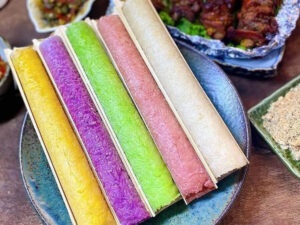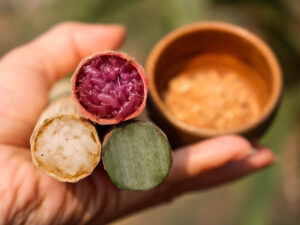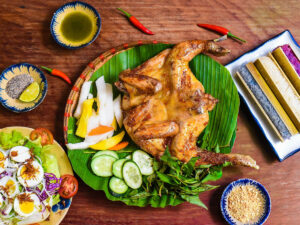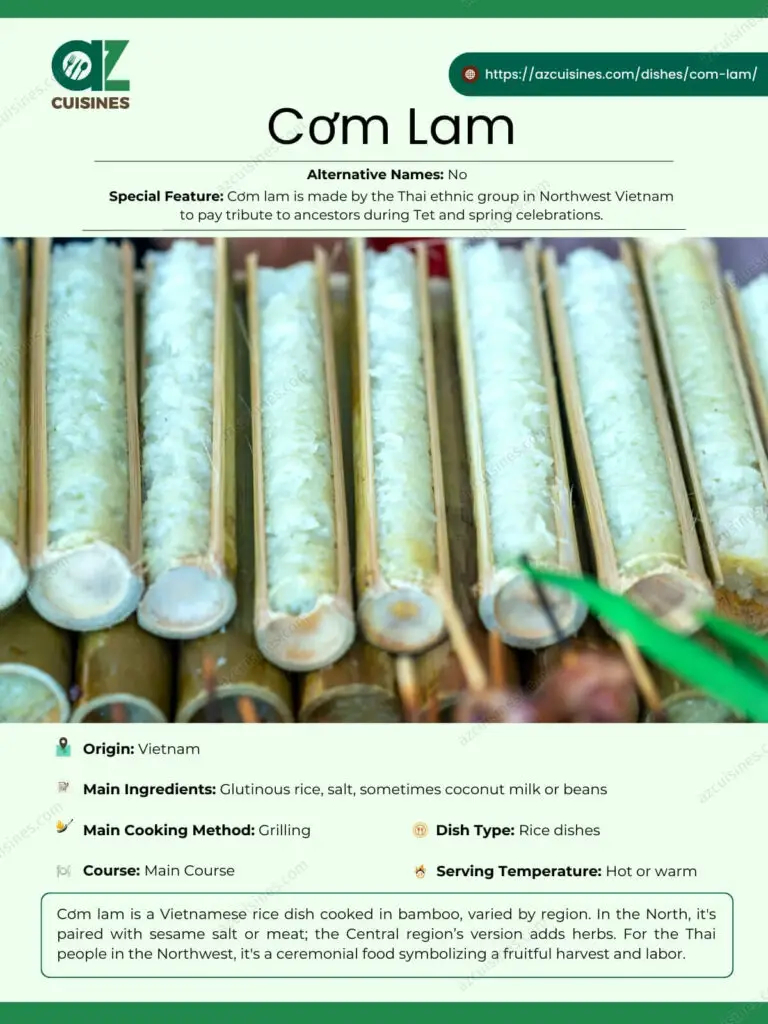#64 in Vietnam
Cơm Lam: Basic Information
Pronunciation
Alternative Name(s)
Dish Type
Course
Mealtime
Popular Cơm Lam Variations

Cơm Lam Tím

Cơm Lam Ngũ Sắc
Cơm Lam: Ingredients and Preparation
Main Ingredients
Main Cooking Method
Preparation Process
Cơm Lam: A Deep Dive
Cultural Significance
Taste
Texture
Aroma
Color
Serving Style
Serving Temperature
Accompaniment
- Grilled meat
- Sesame salt
Occasions
Seasons
Special Diets
Calories
Popularity
Popular Similar Dishes
- Lemang
- Khao Lam
Popular Dining Area
Cơm lam is a Vietnamese dish that consists of rice cooked inside bamboo tubes. Each region in Vietnam adds different flavors. In the northern mountainous regions, cơm lam is typically served with sesame salt or grilled meats.
The central highland versions include the addition of local herbs or serve as a side to savory dishes. Beyond just being a dish, cơm lam is an indispensable specialty of the Thai people in the Northwest that symbolizes good harvest and hard work.
It’s presented on the ancestral altar during the Tet holiday and springtime in the hope of a more prosperous harvest, family warmth, and happiness in the coming year.
Let me guide you through the dish’s features, its beginnings, the components and elements it comprises, the method of preparation, celebrated variations, side items, the best places to sample it, its advantages and disadvantages, frequently asked questions, and dishes that are akin to it.
Key Points
Cơm Lam Images
What Is The Origin of Cơm Lam?
Cơm Lam originated in the Northwest Mountainous Area in Vietnam. The method of cooking rice in bamboo likely began with the mountain people, such as the Tai peoples, who needed a way to prepare and transport their food for long journeys.
They would pack wet rice, with a bit of added salt, into bamboo tubes and then cook it. This not only made the rice portable but also infused it with a distinctive aroma from the bamboo. Cơm Lam is often served with chicken in Central Highlands food stalls.
The practice reflects a resourceful use of natural ingredients and materials for cooking, where bamboo, abundant in the region, provided a means to prepare and contain food.
The dish is a testament to the ingenuity of the local people in using what was available in their environment to meet their needs.
What Are the Ingredients and Materials Needed to Make Cơm Lam?
You’ll need the following ingredients and tools to make Cơm Lam:
| Ingredients/Materials | Description/Details |
|---|---|
| Sticky Rice | Use “nếp cái hoa vàng” or “nếp nương” varieties. |
| Bamboo Tubes | Fresh bamboo tubes (ống tre, ống nứa, or ống hóp) cut into 20-30 cm lengths, must contain moisture inside. |
| Sealing Materials | Corn husks (lõi ngô), banana leaves (lá chuối), or sugarcane pieces (mẩu mía) to seal the tubes. |
Once you’ve gathered these items, you’re ready to proceed with the straightforward preparation of Cơm Lam.
What Is The Making Process of Cơm Lam?
The making process of “cơm lam” is a blend of simplicity and traditional cooking methods that reflect the culinary heritage of Vietnam’s mountainous regions. Here’s a step-by-step description:
Step 1: Soak the Sticky Rice
Submerge sticky rice in water for 8 to 12 hours to soften.
Step 2: Fill the Bamboo Tubes
Stuff the softened rice into bamboo tubes firmly.
Step 3: Seal the Tubes
Close the ends of the tubes with corn husks, banana leaves, or sugarcane pieces.
Step 4: Grill the Rice
Place the tubes on a stand and grill over charcoal, turning them often.
Step 5: Check the Scent
Wait for the sweet smell that signals the rice is cooked.
Step 6: Open the Tubes
Split the bamboo and peel back the outer layer, keeping the thin membrane on the rice and enjoy with accompaniments.
Minor variations in these steps can lead to a variety of cơm lam types, defined by their unique aroma and taste.
What Are The Famous Types of Cơm Lam?
Below are the most well-known types of cơm lam in Vietnam:

Cơm Lam Ngũ Sắc
Multi-colored rice symbolizes the five elements, used for special occasions and represents good fortune and happiness. Often served with various accompaniments suitable for festive celebrations.

Cơm Lam Tím
Purple color from natural dyes, typically eaten with sesame salt and can be paired with various meats. Stays fresh for a week, and ideal for enhancing visual appeal in meals at restaurants or parties.
What to Serve with Cơm Lam?
Here are some dishes that complement cơm lam nicely:

Grilled Meat
In the northern regions, cơm lam is often paired with grilled meats, including pork, chicken, or even wild game, which is marinated and cooked over an open flame for a smoky flavor.

Sesame Salt
A popular condiment in the north, sesame salt is a mixture of toasted sesame seeds and salt, sometimes with added peanuts, which is sprinkled over the cơm lam to enhance its taste.
Exploring these dishes offers a gastronomic journey that mirrors the dining locations of cơm lam, where each region brings its own unique touch to this classic Vietnamese staple.
Where to Try Cơm Lam?
The go-to locales for experiencing cơm lam involve:
In Saigon (Ho Chi Minh City)
Baby Chicken
Address: 800 Xô Viết Nghệ Tĩnh, Ward 25, Bình Thạnh District, Ho Chi Minh City
Gà nướng cơm lam Sài Gòn
Address: 234/55/61 Lê Đức Thọ, Ward 6, Gò Vấp District, Ho Chi Minh City
Gà Kung Fu
Address: 117/5/33 Trần Văn Khê, Bình Thạnh District, Ho Chi Minh City
In Sapa
Cầu Mây Restaurant
Address: 92 Ngũ Chỉ Sơn, Sa Pa, Lào Cai
Nhà hàng Khám Phá Việt
Address: 15 Thạch Sơn, Sa Pa, Lào Cai
Red Dzao House Restaurant
Address: 4b Thác Bạc, Sa Pa, Lào Cai
In Gia Lai:
Bazan Restaurant
Address: Alley 478 – 480, Lê Duẩn Street, Pleiku City
Gà nướng Plei Têng
Address: Hàn Thuyên Street, Tân Sơn Ward, Pleiku City
Ksor Hnao
Address: Alley 49/18 Trần Nguyên Hãn Street, Đống Đa Ward, Pleiku City
While these dining locations offer a chance to indulge in the authentic taste of cơm lam, considering the pros and cons of cơm lam can enhance your appreciation for this traditional dish.
Pros and Cons of Eating Cơm Lam
Weigh the favorable and unfavorable aspects of cơm lam below:
Pros
Cons
Also, it’s important not to skip the commonly queried question that follows.












Truc Tran (Kris)
Senior Food Editor
Expertise
Home Cooking, Meal Planning, Recipe Development, Baking and Pastry, Food Editor, Cooking-video Maker, Vietnamese Food Evaluation Expert
Education
Truc Tran (Kris), an experienced food writer and editor, is great at exploring and describing global cuisines, from simple street food to fancy dining. In her writing, she skillfully mixes different flavors, cooking methods, and culinary traditions, showing the unique character of various cultures through their food and drinks. On azcuisines.com, Kris highlights her knowledge, especially in Asian cuisine and worldwide traditional dishes.